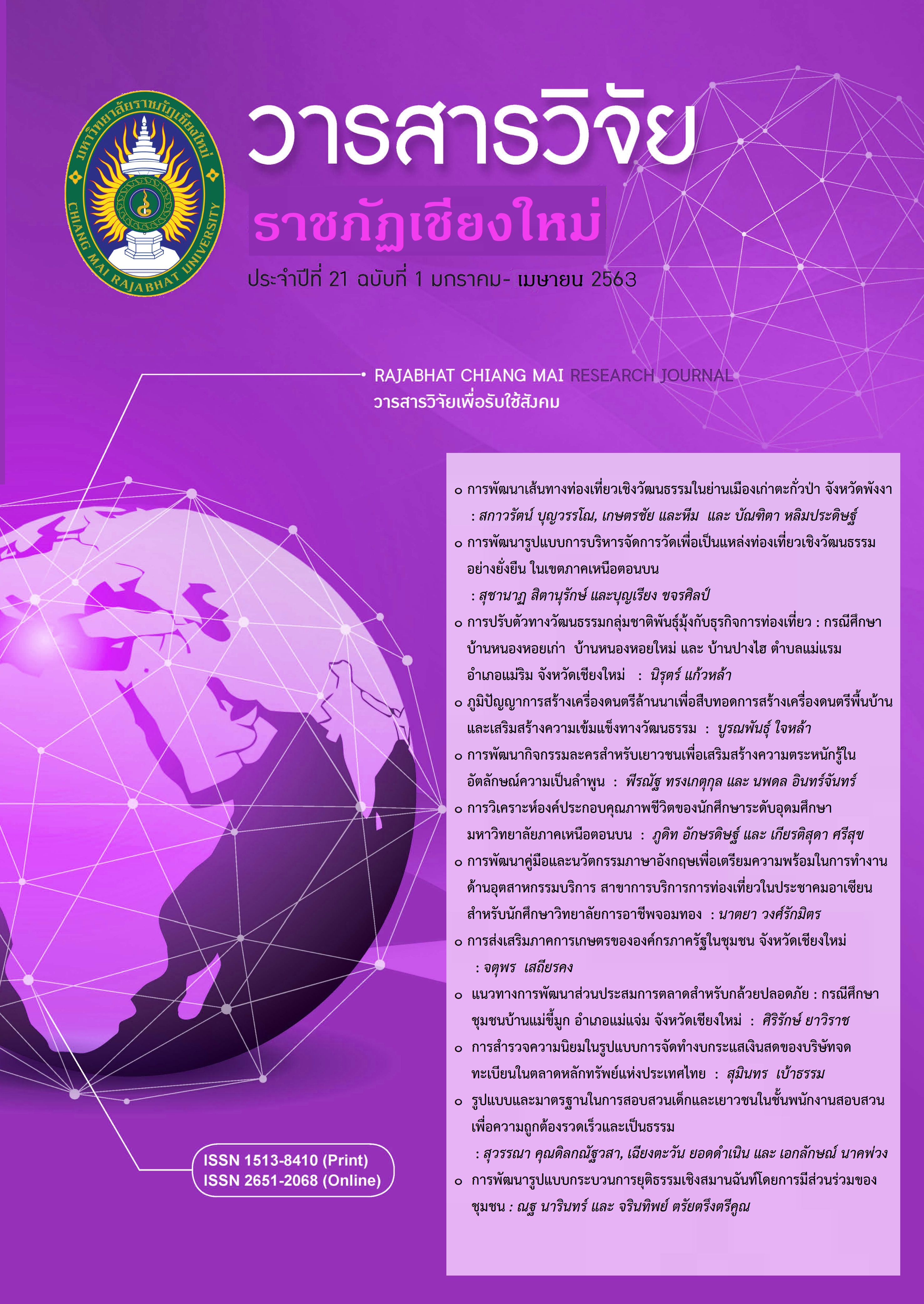Adaptation of Hmong’s Cultural with Business Tourism : A Case Study of Nonghoi Gao, Nonghoi Mai and Pang Hi village, Mae Ram Sub district, Mae Rim District, Chiang Mai
DOI:
https://doi.org/10.14456/rcmrj.2020.194086Keywords:
Music culture, EthnomusicologyAbstract
Adaptation of Hmong’s Cultural with Business Tourism : A Case Study of Nonghoi Gao, Nonghoi Mai and Pang Hi village, Mae Ram Sub district, Mae Rim District, Chiang Mai is an basic research, using qualitative research methodology. Research findings found that people of this community still have their Hmong lifestyles which are culturally inherited includes Hmong dressing, musical playing, Hmong playing, Hmong new year tradition, Hmong marriage, Hmong singing, and eating tradition. Hmong lifestyles has adaptation from Agricultural society to Cultural tourism.
Study of knowledge about musical instruments, songs, and performance of Hmong ethnics groups found that there are music instruments such as Keng, Trablai, singing song, Keu Chia, singing song for asking marriage, funeral hymn, lyrics from Keng music instrument with complicated structure, non-rigid rhythms, and audio range of Keng’s song has minimum sound with one higher range. The sound system of Pentatonic, with unclear pattern of rhythms. Rhythm pattern has both a crotchet and two quavers.
The application for music culture and performance for introducing ethnic’s tourism in studied area should restore music knowledge by different methods such as promoting music activities for community. The promotion of music into online learning and teaching at the school level, with inserting local curriculum. Learners will understand about sound of music, singing sound, music instruments, and roles and functions. Further, learning to move up and down of the melody, composition of music, music vocabulary of lyrics, using media for learning and studying about ethnic music in order to promote local music in music curriculum. Thus, this is a way to promote learners and people who are interested to have clear examples with empirical evidence to further develop the media by themselves.
Downloads
References
ธนพชร นุตสาระ. (2560). หน่อซื่อแหล่ะ เครื่องดนตรีลาหู่. วารสารวิจัยราชภัฏเชียงใหม่, 18(2), 22-35.
นิรุตร์ แก้วหล้า. (2557). การศึกษาเครื่องดนตรีของกลุ่มชาติพันธุ์ลาหู่ในเขตพื้นที่โครงการหลวงอ่างขาง อำเภอฝาง จังหวัดเชียงใหม่. วารสารวิจัยราชภัฏเชียงใหม่, 16(1), 44-55.
ปรานี วงษ์เทศ. (2530). “ความเชื่อของชาวอีสาน”, ใน วัฒนธรรมพื้นบ้าน : คติความเชื่อ. กรุงเทพมหานคร:จุฬาลงกรณ์มหาวิทยาลัย.
ยงยุทธ ธีรศิลป์. (2538). เจ็ดทศวรรษ: ราชภัฎเชียงใหม่กับสืบสานวัฒนธรรม. เชียงใหม่: สถาบันราชภัฎเชียงใหม่.
รัฐสินธุ์ ชมสูง. (2560). วงสะล้อ ซอ ปิน ของครูอรุณศิลป์ ดวงมูล. วารสารวิจัยราชภัฏเชียงใหม่, 18(2), 6-20.
สุกรี เจริญสุข. (2530). ดุริยางคศาสตร์ชาติพันธุ์. วารสารถนนดนตรี, 1(12), 38- 41.
อนรรฆ จรัณยานนท์. (2548). เอกสารประกอบการสอนวิชาการวิเคราะห์ดนตรีสากล. วิทยาลัยดุริยางคศิลป์ มหาวิทยาลัยมหิดล.
Hornbostel, V., Sachs, C. (1940). The history of musical instruments [by] Curt Sachs . New York, W.W. Norton & company, inc.
Merriam, A., P. (1964). Anthropology of music. Chicago: University Press.
Myers, H. (1992). Ethnomusicology An Introduction. W.W.Norton & Company: Inc.Center.
Nettl, B. (1972). Music in Primitive Culture. London: Oxford University Press.
Downloads
Published
How to Cite
Issue
Section
License
1. Articles, information, content, images, etc published in the “Community and Social Development Journal” are copyrighted by the Community and Social Development Journal, Chiang Mai Rajabhat University. In order to properly distribute the articles through print and electronic media, the authors still hold the copyright for the published articles under the Creative Commons Attribution (CC BY) license, which allows the re-distribution of the articles in other sources. References must be made to the articles in the journal. The authors are responsible for requesting permission to reproduce copyrighted content from other sources.
2. The content of the articles appearing in the journal is the direct responsibility of the article authors. The editorial board of the journal does not necessarily agree with or share any responsibility.














